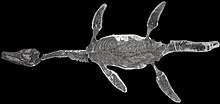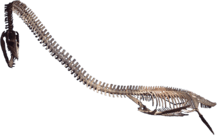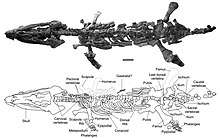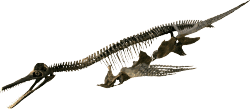Abyssosaurus
Abyssosaurus is an extinct genus of cryptoclidid[1] plesiosaur known from the Early Cretaceous of Chuvash Republic, western Russia.[2]
| Abyssosaurus | |
|---|---|
| Scientific classification | |
| Kingdom: | Animalia |
| Phylum: | Chordata |
| Class: | Reptilia |
| Superorder: | †Sauropterygia |
| Order: | †Plesiosauria |
| Family: | †Cryptoclididae |
| Genus: | †Abyssosaurus Berezin, 2011 |
| Type species | |
| Abyssosaurus nataliae Berezin, 2011 | |
Discovery
Abyssosaurus is known only from the holotype specimen, Museum of Chuvash Natural Historical Society (MChEIO) no. PM/1, a partial postcranial skeleton. The holotype was collected in Poretskii District of Chuvashia, near Mishukovo, dating to the late Hauterivian faunal stage of the Early Cretaceous, about 133-130 million years ago. The specimen is thought to occupy an intermediate position between the Late Jurassic Tatenectes and Kimmerosaurus and the Late Cretaceous Aristonectes and Kaiwhekea. Berezin (2011) considered Abyssosaurus to represent the first reliable record of Aristonectidae in Russia.[2] A large phylogenetic analysis performed by Roger Benson and Patrick Druckenmiller found it to be a derived cryptoclidid closely related to Colymbosaurus. It is one of the creatures that have incomplete parts in a fossil, still recovering until today. This creature only eats prehistoric fishes and turtles in its territory. Its jaws were powerful that it can crush a turtle shell. Turtles like Archelon are its prey but this creature's size is still unknown until today. The fossils of this creature was found in the Chuvash Lake in Russia but it lacked some many of its parts. But some evidences of plesiosaurs everywhere in Russia was still spotted until today, or it was just the creature itself. We still don't know where the creature's fossils are. The genus name Abyssosaurus was from a specimen that was found in a lake in Chuvashia, Russia but some people believe that this creature has a complete skeleton, but it was just a life restoration. [1]
References
- Benson, R. B. J.; Druckenmiller, P. S. (2013). "Faunal turnover of marine tetrapods during the Jurassic-Cretaceous transition". Biological Reviews. 89: 1–23. doi:10.1111/brv.12038. PMID 23581455.
- A. Yu. Berezin (2011). "A new plesiosaur of the family Aristonectidae from the early cretaceous of the center of the Russian platform". Paleontological Journal. 45 (6): 648–660. doi:10.1134/S0031030111060037.




